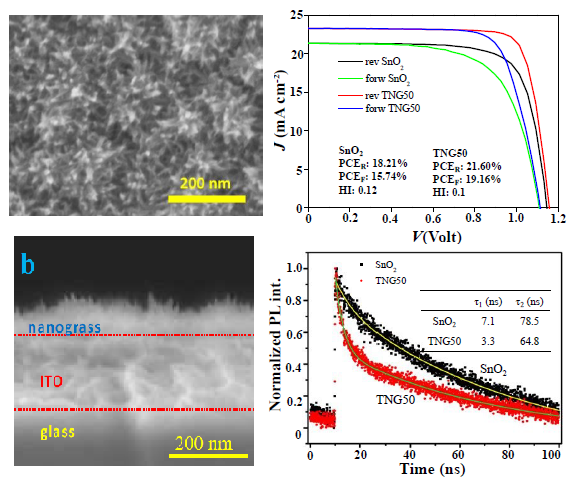Enhancing the interfacial carrier dynamic in perovskite solar cells with nanograss-like TiO2 electron transport layer
Journal: Journal of Materials Chemistry A, Impact Factor 11.3 (click here for full paper)
Authors:
Contact details for further info: akrajas@ukm.edu.my
Summary:
The efficient electron transfer at the interface of the electron transport layer (ETL) and perovskite, and the transportation along the ETL and collection at the electrode are characteristics that are critically governed by the properties of the ETL. Both characteristics are fundamental for the fabrication of high-performance perovskite solar cells (PSC). So far, mesoporous TiO2 might be considered a versatile ETL as its structure can provide an enormous heterojunction with the perovskite absorber. However, its inert (101) pore facet, massive dead-end pore structure, and extensive grain boundary with the underlying layers in the PSC device have made them unlikely to meet those basic criteria. Here, we have come up with a new design of TiO2 ETL that provides a high carrier dynamic in the device. It is a 3 nm thick high-energy (001) faceted single-crystalline nanograss-like structure (TNG) that is vertically grown on the ITO surface. With these unique structural properties, we achieved an enhanced carrier extraction from the perovskite layer, transportation along the ETL and collection at the electrode. Our results indicate that the charge-transfer dynamic at the TNG–perovskite interface and transport in the device are up to more than 2 times faster than those in the control device or in the recently reported results. With this property, we recorded a power conversion efficiency (PCE) as high as 21.60% (or at the level of 20.84% on average) from the TNG-based PSC with the device area as high as ∼0.17 cm2 using triple cation Cs0.05[MA0.13FA0.87]0.95Pb(I0.87Br0.13)3 perovskites, an improvement as high as 18% from the control device. The TNG with its unique structure and surface chemistry may become a potential platform for the fabrication of a high-performance PSC device via combination with a high-performance perovskite system


